Terms and rules for picking eggplant seedlings at home
It is a good thing, preparing for the onset of the summer cottage season, to think about growing eggplant seedlings, especially picking it. After all, this seemingly simple, but very effective procedure, like no other, contributes to the active development (branching) of the root system of the future plant, and ultimately to obtaining an excellent harvest.
You will learn more about how and when to do it correctly, without harming the plant, as well as about direct picking and about leaving after it.
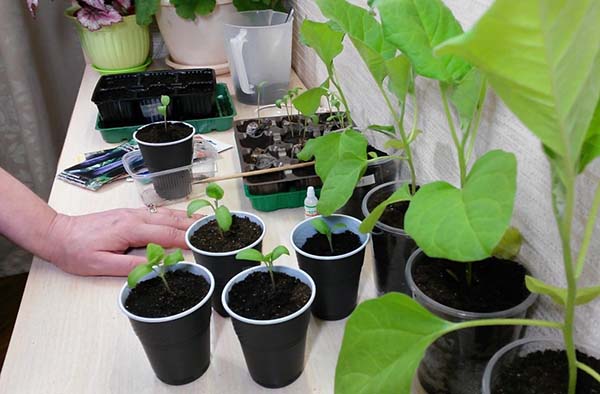
Content
Do I need to dive eggplant seedlings?
In short, yes, it is necessary, but it is not necessary to dive, where it is better to cross with a lump of earth. Read more about everything in more detail.
It is believed that eggplants, like peppers, do not like transplanting: they tolerate a pick rather painfully and subsequently take root in a new place for a long time, so to speak, freeze for a while in development (unlike the same tomatoes).
However, if you carry out the procedure as carefully and carefully as possible, trying to injure the root system of the plant to a minimum, then the eggplants will perfectly recover and grow.
Interesting! The classic definition of picking (diving) is the removal of the final part of the taproot from a young seedling in order to stimulate branching of the root system (however, if for tomatoes it is a blessing, then for eggplants and peppers it is unacceptable!). However, as a rule, picking means planting seedlings from a common container into individual containers.
Is it possible to grow eggplant seedlings without picking
Of course, this question is more than obvious and logical, because you can just take and immediately plant the peppers in large containers (containers), then immediately plant them in open ground or a greenhouse, thereby avoiding the picking procedure.
However, seedlings are initially sown in small containers for a reason:
- First, the seedlings weak root systemwhich is simply unable to immediately master the entire soil. At the same time, the empty volume of the land often turns sour, especially with gross errors with watering. Naturally, this plant can be severely damaged.
- Secondly, small containers are much more convenient to place under phytolamps or on a windowsill where there is more light. After all, if you grow a large number of seedlings, then in any case it will not have enough space "under the sun". But illumination plays a key role precisely for very young plants that grow even under conditions of short daylight hours (up to 10 hours).
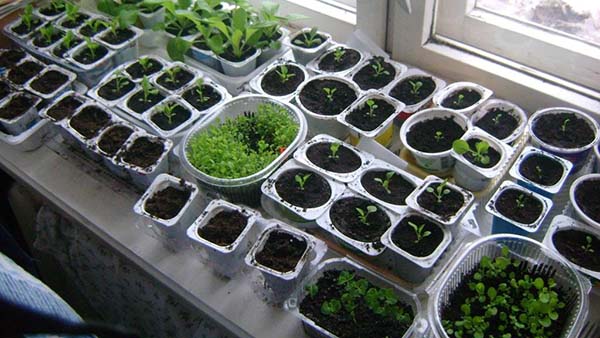
However! You still you can grow eggplants without picking, but you still can't do without a transfer (transshipment). In other words, you need to initially sow not in a general container, but in individual small-volume cups, for example, the same cassettes, in order to transplant as they grow, or rather transfer the grown seedlings together with an earthen lump (completely preserving it) into large containers.
When to dive eggplant seedlings: optimal timing
The picking of eggplant seedlings, like almost all other plants, must be carried out when the plants form a pair (2 each) of these leaves... This usually comes 3-4 weeks after germination.
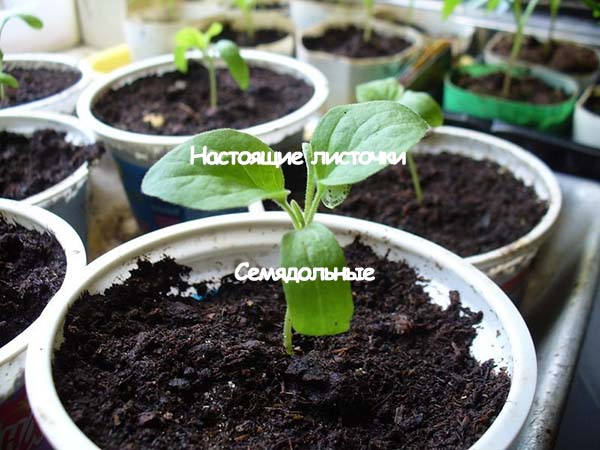
Note! Of course, it is possible to swoop down at the stage of cotyledon leaves, but the young sprout will be too weak, which means there will be a high probability of damage during transplantation, and then further death. Moreover, you should not do this in the case of eggplants or peppers.
Thus, you should not rush, as well as delay, with the eggplant picking: if in the first case the plant is too weak, then in the second it will simply start to lack space and food, which means that the seedlings will begin to stretch out and wither.
However, if you originally sown seedlings in separate containers, for example, in cassettes, then picking can be carried out at the stage of 3-4 real leaves, and in this case it will be not a classic pick, but transshipment.
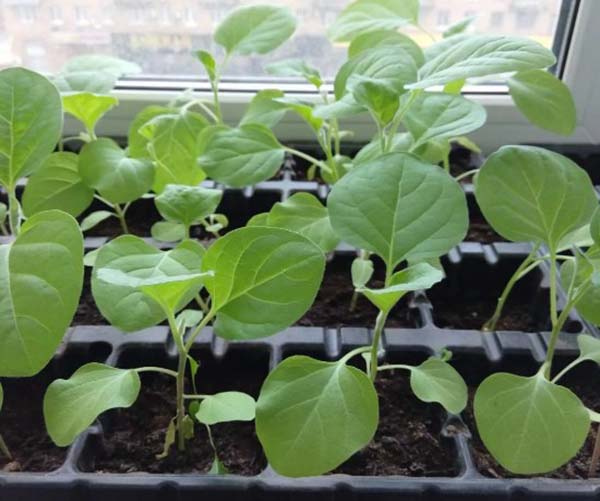
Video: dive eggplants and peppers on time
How to properly dive eggplant seedlings: basic rules, recommendations and step-by-step instructions
So, now you have already noticed that the eggplant seedlings have formed 2 real leaves, which means it's time to pick. But before doing it, you should properly prepare for the procedure. This is not difficult.
Soil preparation
The soil for picking eggplants is exactly the same as when sowing seeds for seedlings, in other words, it should be loose, light and neutral in acidity (pH 6.5). Unless now it can be made a little more nutritious.
And of course, don't forget disinfect in one of the ways.
You can disinfect the soil with a solution Fitosporin (according to the instructions) either steaming in the oven or microwave... Better yet, do both, but in the reverse order (first heat treatment, and then spill with fungicide).
The easiest way is to use a ready-made special soil for growing eggplant seedlings, which is also suitable for peppers and tomatoes.
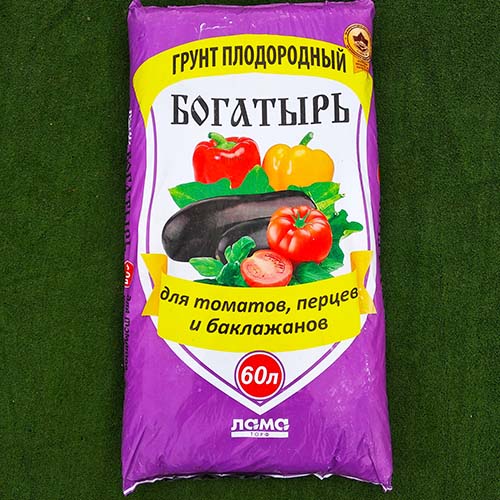
Of course, you can always prepare the soil mixture yourself. Here are some proven recipes:
- sod land, high peat, humus or compost, sphagnum moss or river coarse sand in a ratio of 1: 1: 2: 1;
- peat, compost or humus, sand in a ratio of 2: 2: 1;
- turf soil, humus or compost, sand in a ratio of 1: 2: 1;
- turf land, leaf land, humus or compost in equal proportions (1: 1: 1);
Important! Do not forget to add to all potting mixes wood ash at the rate of 1 glass (100 grams) per bucket of soil mixture (which approximately corresponds to a package of soil with a volume of 20 liters).
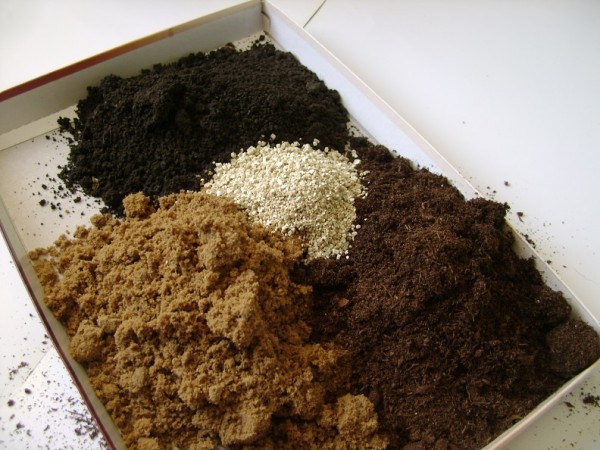
Dive container
When picking eggplant seedlings into separate containers, their volume should be at least 0.5 liters (height - 8 cm, diameter - 10 cm) and no more than 1 liter (otherwise it is pointless and even harmful).
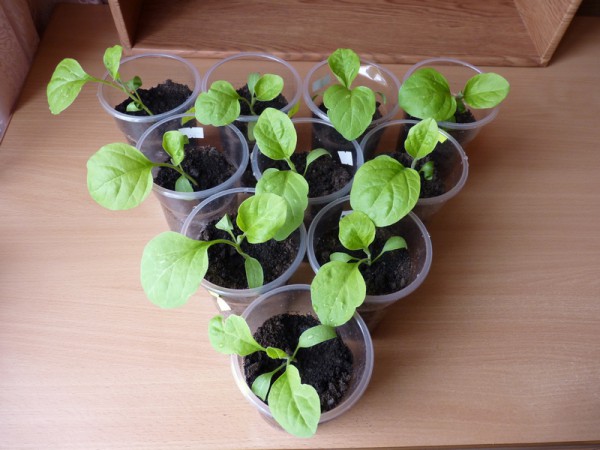
Note! If you take a container of a smaller volume (0.2-0.3 liters), then after a while you will need to carry out another transplant again, more precisely, a transshipment.
Also, the landing container must have drain holes, or you need lay out the drainage layer from expanded clay or pebbles (1-2 cm), but you can do both (but not at all).
Direct pick
Step-by-step instructions for picking eggplant seedlings into separate containers:
Advice! If desired, a couple of hours before the pick, to neutralize stress, seedlings can be sprayed with one of the growth regulators (stimulants), for example, "Epin" or "Zircon" (according to the instructions).
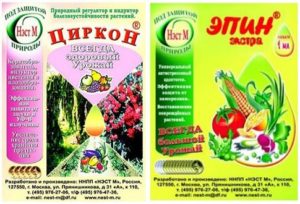
- A few hours before the dive, young seedlings should first be slightly spilled with warm water so that the soil does not crumble from the roots when diving or the earthen lump is well separated (during transshipment).
Alternative opinion! In order for the seedlings to remain elastic and not break during the pick, on the contrary, it is advisable to slightly dry the soil before the procedure.
- Fill individual containers with soil (but not completely, by about 2/3, so that you can water the plant normally and add soil as it grows).
- Make small depressions in the middle of the containers (holes, more precisely, cone-shaped pits).
- Carefully remove the seedling from the container.
If you dive seedlings from a common container, then it is quite difficult to keep an earthen lump, but it is still worth trying so that at least a small layer of earth remains on the roots. Therefore, slowly, using a spoon or stick, pry up the roots from below and carefully remove the plant from the soil.
But if you transplant (more precisely, transfer) from cassettes or individual containers of small volume, then this must be done together with an earthen lump (it's quite simple).
- Optionally, you can dip the roots in the solution to enrich the root system with beneficial bacteria. "Fitosporin" (against fungal diseases) and / or "Azotovita" or "Azofita" (both drugs are analogs providing nitrogen nutrition), "Phosphatovite"(Phosphorus nutrition). Prepare solutions only according to the instructions on the packaging.
Note! Solutions can be mixed, drugs do not suppress each other.
You can also add a drop to the resulting solution "Epina" (or "Zircon") or 1 h. l. yeast (culinary, beer) - so it will be even more effective.
- Place the seedling in the hole, slightly deepening, about half of the stem (you can deepen a maximum of 1-1.5 cm from the original state).
Note! It is not necessary to deepen the eggplant seedlings when picking to, especially along the cotyledon, it is useless and even harmful (the root collar can rot).Another thing is when it comes to tomatoes, they have adventitious roots on the stem (not for eggplants and peppers!).
- Then you spill it with warm water so that the roots of the plant come into good contact with the soil.
If desired, watering can be done with a solution "Fitosporin" and Azofita (Azotovita).
- To prevent a dry crust from forming after watering, you can additionally add a little soil on top.
By the way! For prevention black leg and other fungal diseases, you can put a Glyocladin tablet in each container.
- Finally, put the cut seedlings in a place inaccessible to direct sunlight, for about a day or two (24-48 hours), and if transshipment was carried out, then for 12-24 hours. In other words, it is better to remove containers with seedlings from the window and put them on the table or somehow shade them directly on the windowsill. Shading does not mean placing in a deep shadow or even in a dark place.
The classical picking process is shown with the use of drugs "Fitosporin" and Azofit.
Video: picking eggplants, peppers, tomatoes - simple rules
And in the next video, the author recommends picking eggplants when they only have 1 real leaf each. Whether it is worth doing a dive so early is a question. But in general, the instructions are very descriptive.
Video: how to dive eggplants
In this video, the author completely pinches off the root and deepens the seedlings to the very cotyledons, while being completely satisfied with his method of picking.
Caring for eggplant seedlings after picking
Then you continue to care for the eggplant seedlings in a similar way: you maintain the temperature (+ 20-25 degrees during the day, and + 18-20 at night) and light regimes (optimally 12 hours) and water the plants in a timely manner (as the top layer of the earth dries up) , and also start feeding (if necessary).
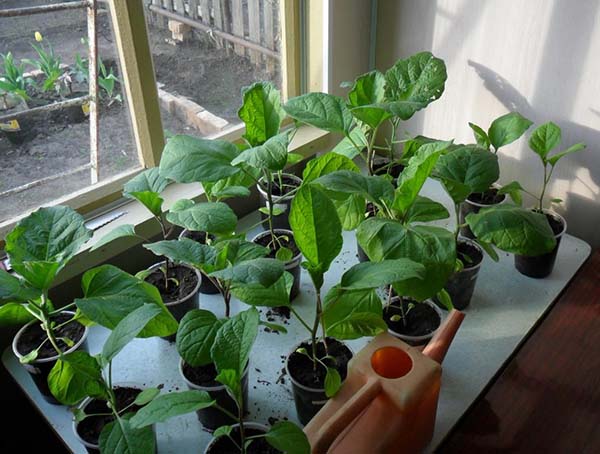
Important! In no case should the seedlings be hypothermic after transplantation. Plants can get sick very easily at this point. But they do not need too high a temperature (above +30 degrees).
You can start feeding eggplant seedlings no earlier than 10-14 days after the pick (and then you can repeat it again every 10-14 days), just at this time it adapts to a new place.
Important! If you initially prepared a nutritious soil mixture, in other words, thoroughly fertilized it (by adding humus or compost to it, wood ash), then, as a rule, you can do without feeding. However, if the appearance of the seedlings raises concerns, then feeding should be done without fail.
As a rule, in the event of a lack of nutrition, the lower leaves begin to turn yellow first, i.e. the plant begins to use the substances accumulated in them.
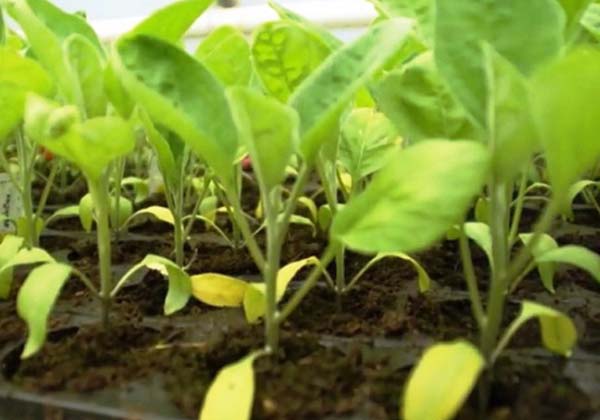
For example, first feeding can be like this: 10 grams dryyeast dissolve in 1 liter of water, let it brew for 4-6 hours and pour under the root.
Advice! For more active reproduction of yeast, add 4-5 tbsp. tablespoons of sugar.
Next dressing should be done againin 10-14 days. Suitable for this solution wood ash (10-20 grams per 1 liter) and ammonium nitrate (1-2 grams per 1 liter of water).
Important! If solutions of organic fertilizers can be applied on dry soil, then mineral fertilizers - only on wet.
The last feeding should be given 10-14 days before landings... For example, it could be herbal infusion (or any other nitrogen fertilizer, for example, the same mullein or poultry (chicken) droppings solution).
If you do not want to bother, then for feeding eggplant seedlings it is best to use complex mineral fertilizerscontaining approximately or completely equal amounts of nitrogen, phosphorus and potassium. Moreover, it is desirable prepare 2-3 times less concentrated solutionsthan the manufacturer recommends.
By the way! The same Fertika Lux and Gumi-Omi (organic fertilizer) will do.
In order to successfully manage your garden plot in the summer and enjoy the eggplant harvest in the fall, you need to grow strong seedlings in the spring, including cutting them correctly. However, first of all, it is very important to decide when and how to dive the eggplants, as well as how to properly care for the seedlings after the transplant procedure.
Video: picking eggplants and peppers using the transshipment method


After a glass of ash on a bucket, I didn't even read))))
And why? Do you think that this is too little, you need 2-3?